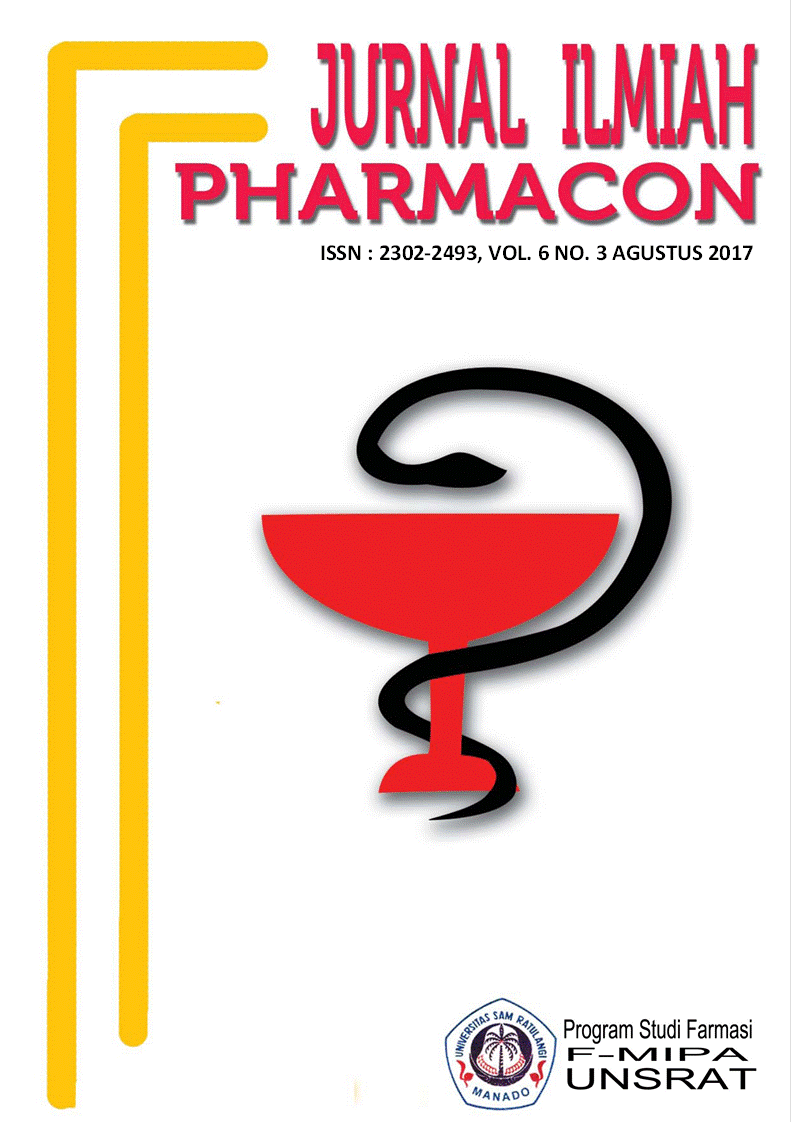IDENTIFIKASI DAN UJI RESISTENSI BAKTERI DARI PLAK GIGI PASIEN DENGAN TUMPATAN AMALGAM DI PUSKESMAS TIKALA BARU TERHADAP MERKURI DAN ANTIBIOTIK GOLONGAN PENISILIN
DOI:
https://doi.org/10.35799/pha.6.2017.16884Abstract
IDENTIFIKASI DAN UJI RESISTENSI BAKTERI DARI PLAK GIGI PASIEN DENGAN TUMPATAN AMALGAM DI PUSKESMAS TIKALA BARU TERHADAP MERKURI DAN ANTIBIOTIK GOLONGAN PENISILIN
Â
Rawis Eirene Christi1), Fatimawali1), Adithya Yudistira1)
1)Program studi farmasi FMIPA UNSRAT Manado, 95115
Â
ABSTRACT
Â
Metallic mercury is widely used as a patch of cavities which commonly called amalgam. The activity of chewing food and drinking increases the frequency of the amalgam discharge, so that mercury vapor from amalgam enters the human body and can cause damage to the body. Mercury toxicity can be reduced by using mercury resistant bacteria, but if these bacteria also have antibiotic-resistant compounds it will have a negative impact. The objective of the study was to investigate mercury-resistant bacteria and antibiotics in dental plaque of patients with amalgam. This study used descriptive explorative method with dental plaque samples from 3 patients at Tikala Baru Community Health Center, as well as mercury and antibiotic amoxicillin that already exist in Pharmacy laboratory. The results showed that the were three bacteria identified are Staphylococcus sp., Brucella sp. and Phenylobacterium sp. Fifteen bacterial isolates were grown in Nutrien Broth medium with concentration of HgCl2 10 ppm, 20 ppm, 40 ppm so that the bacteria had been mercury resistant and in 3 repetitions of amoxicillin antibiotics, 14 isolates were found in the resistant category and 1 bacterial isolate in the intermediate category.
Â
Keywords: dental plaque, bacteria, resistance, mercury, amoxicillin
Â
ABSTRAK
Â
 Logam merkuri banyak digunakan sebagai penambal gigi berlubang yang biasa disebut amalgam. Kegiatan mengunyah makanan dan minum minuman menaikan frekuensi lepasnya amalgam, sehingga uap merkuri dari amalgam masuk dalam tubuh manusia dan dapat menyebabkan kerusakan pada tubuh. Daya toksik merkuri dapat diturunkan dengan menggunakan bakteri resisten merkuri, akan tetapi bila bakteri ini juga memiliki senyawa yang resisten terhadap antibiotik maka akan memberi dampak negatif. Tujuan dari penelitian untuk mengetahui bakteri yang resisten merkuri dan antibiotik pada plak gigi pasien dengan tumpatan amalgam. Penelitian ini menggunakan metode deskriptif eksploratif dengan sampel plak gigi dari 3 orang pasien di Puskesmas Tikala Baru, merkuri dan antibiotik amoksisilin yang sudah ada di laboratorium Farmasi. Hasil penelitian menunjukan bahwa bakteri-bakteri yang teridentifikasi ada tiga yaitu Staphylococcus sp., Brucella sp. dan Phenylobacterium sp. 15 isolat bakteri bertumbuh pada media Nutrien Broth dengan konsentrasi HgCl2 10 ppm, 20 ppm, 40 ppm sehingga bakteri tersebut telah resisten merkuri dan dalam 3 kali pengulangan pengujian antibiotik amoksisilin didapatkan 14 isolat bakteri dalam kategori resisten dan 1 isolat bakteri dalam kategori intermediate.
Â
Kata kunci: plak gigi, bakteri, resistensi, merkuri, amoksisilin
Â
Downloads
Published
How to Cite
Issue
Section
License
Authors who publish with this journal agree to the following terms:
- Authors retain copyright and grant the journal right of first publication with the work simultaneously licensed under a Creative Commons Attribution-NonCommercial 4.0 International License that allows others to share the work with an acknowledgement of the work's authorship and initial publication in this journal.
- Authors are permitted and encouraged to post their work online (e.g., in institutional repositories or on their website) prior to and during the submission process, as it can lead to productive exchanges, as well as earlier and greater citation of published work (See The Effect of Open Access)










